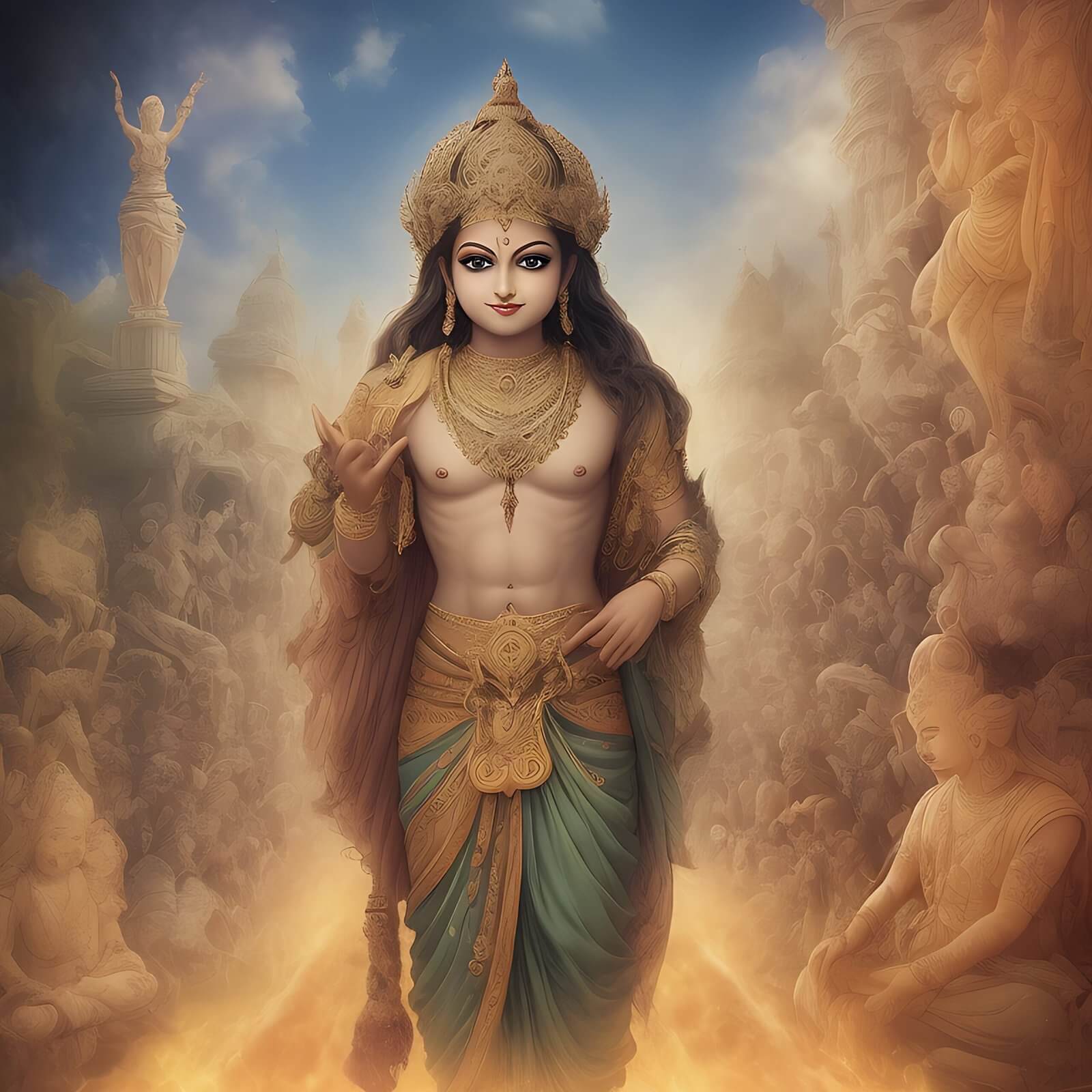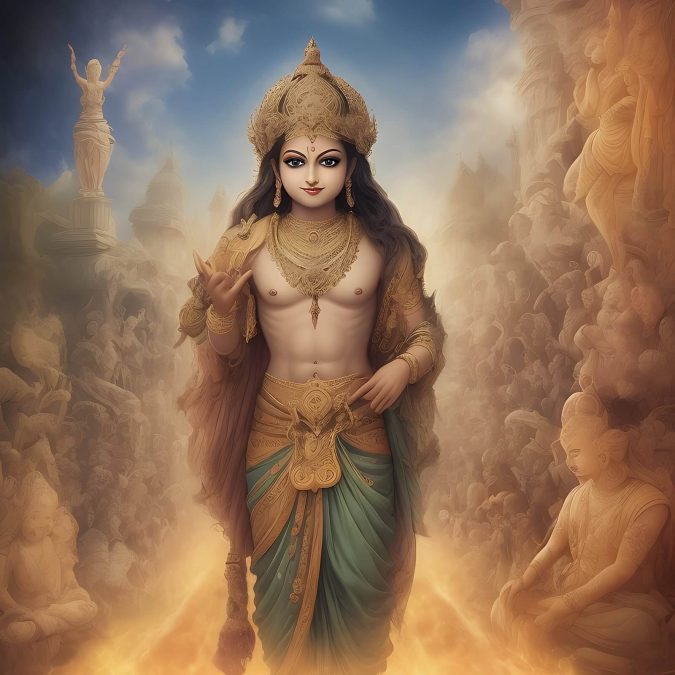
Matsya, an ancient Hindu deity in Indian mythology. Matsya is depicted as a fish, and is believed to be the first avatar (incarnation) of the god Vishnu. The page describes the origin story of Matsya, where he saves Manu, the first man, from a great flood by guiding his boat. It also explores the symbolism associated with Matsya, representing preservation and protection. The page provides details about Matsya’s appearances in various Hindu texts like the Mahabharata and the Puranas. Additionally, it mentions the significance of Matsya in Hindu art and architecture, with numerous sculptures and temples dedicated to the deity found across India.
The story of Matsya, the first avatar of the god Vishnu in Hindu mythology, begins with a great flood that threatens to destroy the world. In this tale, Manu, the first man, is performing a water ritual when a tiny fish approaches him. The fish pleads for help, promising to save Manu from the impending flood. Manu agrees and takes the fish into a pot of water, which the fish quickly outgrows. Manu then transfers the fish to a larger vessel, and it continues to grow rapidly until it is too large for the vessel.
Realizing that the fish is no ordinary creature, Manu asks for its true identity. The fish reveals itself to be Vishnu, one of the principal deities in Hinduism, and informs Manu of the impending flood. Vishnu instructs Manu to build a massive boat and take along the seven sages, seeds of all plants, and pairs of animals to survive the cataclysm. As the floodwaters rise, Matsya (the fish avatar of Vishnu) guides the boat through the turbulent waters, ensuring the survival of life on Earth.
After the floodwaters recede, Matsya reveals his true form to Manu and imparts divine knowledge to him. This knowledge includes the principles of dharma (righteousness) and the means to create civilization and sustain life on Earth. Through this act, Matsya symbolizes protection, preservation, and the restoration of order in the face of chaos and destruction.
The story of Matsya is not only a tale of rescue and preservation but also carries deep spiritual and philosophical meanings. It underscores the cyclical nature of creation, destruction, and rebirth in Hindu cosmology, as well as the belief in divine intervention to uphold righteousness and protect the world from calamity. Matsya’s role as the savior of Manu and all living beings establishes him as a central figure in Hindu mythology, revered for his benevolence and protective powers.
1. Matsya: The central character in the story, Matsya is the first avatar of the god Vishnu in Hindu mythology. Depicted as a fish, Matsya saves Manu and all living beings from a great flood by guiding a boat to safety. Matsya symbolizes preservation, protection, and divine intervention in times of crisis.
2. Manu: Manu is the first man in Hindu mythology and plays a crucial role in the story of Matsya. He listens to the fish’s plea for help, builds a boat as instructed by Matsya, and ensures the survival of life during the flood. Manu is considered the progenitor of humanity in Hindu tradition.
3. Vishnu: Vishnu is one of the principal deities in Hinduism and the divine being behind the Matsya avatar. Vishnu takes the form of a fish to rescue Manu and the world from destruction, showcasing his role as the preserver and protector in the Hindu pantheon.
4. Seven Sages: In the story, Manu is instructed to bring along seven sages on the boat during the flood. The sages represent wisdom, knowledge, and the preservation of ancient teachings in Hindu tradition.
5. Animals: Manu is also directed to gather pairs of animals to accompany him on the boat, ensuring the survival of various species during the flood. The animals symbolize the diversity of life and the importance of harmony and balance in the natural world.
6. Seeds of Plants: Along with the animals, Manu is instructed to collect seeds of all plants to preserve the botanical diversity and ensure the sustenance of plant life after the floodwaters recede. This act emphasizes the interconnectedness of all living beings and the need for environmental preservation.
The story of Matsya in Hindu mythology, where a divine fish avatar saves Manu and pairs of animals from a catastrophic flood by guiding them on a boat, shares striking similarities with the biblical tale of Noah’s Ark. While the two narratives come from different cultural and religious traditions, they both depict a cataclysmic flood and the preservation of life through the construction of a vessel under divine guidance. Here are some key points of similarity between the stories of Matsya and Noah’s Ark:
1. **Divine Intervention and Warning**: In both stories, a divine being (Vishnu as Matsya in Hindu mythology and God in the Bible) warns a chosen individual (Manu in Hinduism and Noah in Judaism and Christianity) about an impending flood that will destroy all life on Earth. The divine figure instructs the individual to build a vessel to survive the deluge.
2. **Construction of a Boat**: In both narratives, the chosen individual follows the instructions given by the divine being and constructs a large boat to save themselves, their family, and pairs of animals. The boats serve as vessels of preservation and protection during the catastrophic event.
3. **Preservation of Life**: The purpose of building the boats in both stories is to ensure the survival of life on Earth. The individuals are tasked with taking pairs of animals and seeds of plants onto the boat to repopulate the world after the floodwaters recede. This act symbolizes the preservation of biodiversity and the continuation of life.
4. **Cataclysmic Flood**: Both stories feature a massive flood that covers the Earth, leading to widespread destruction and loss of life. The flood is portrayed as a divine punishment or cleansing of the world, emphasizing the themes of renewal, rebirth, and the cycle of creation and destruction.
5. **Restoration and Guidance**: After the floodwaters recede, the divine figure (Matsya or God) reveals their true identity and imparts knowledge or blessings to the survivor (Manu or Noah). This guidance serves as a blueprint for rebuilding civilization, upholding righteousness, and maintaining order in the post-flood world.
These similarities between the stories of Matsya and Noah’s Ark highlight universal themes of catastrophe, salvation, and renewal found in different cultural and religious traditions. The narratives of divine intervention, the construction of a boat to escape the flood, and the preservation of life resonate across Hindu and Abrahamic faiths, illustrating shared beliefs in the protection and sustenance of life in the face of natural calamity.
There are various books and texts that delve into the stories and themes related to Matsya, the first avatar of Vishnu in Hindu mythology. Here are some notable books that explore the narrative of Matsya and its significance in Hindu tradition:
1. “Vishnu: Hinduism’s Blue-Skinned Savior” by Deepak Chopra: This book provides an in-depth exploration of Vishnu, one of the principal deities in Hinduism, and delves into the mythology surrounding Vishnu’s avatars, including Matsya. Deepak Chopra offers insights into the symbolism, teachings, and spiritual significance of Vishnu’s incarnations.
2. “Myth = Mithya: A Handbook of Hindu Mythology” by Devdutt Pattanaik: Devdutt Pattanaik is a renowned author and mythologist who explores Hindu mythology in his works. In this book, he delves into various Hindu myths and legends, including the stories of Vishnu’s avatars like Matsya, and provides interpretations and insights into the symbolic meanings behind these narratives.
3. “The Vishnu Purana” translated by H. H. Wilson: The Vishnu Purana is a sacred Hindu text that is dedicated to the deity Vishnu and his various forms and incarnations. This translation by H. H. Wilson offers readers a comprehensive look at the myths, legends, and teachings associated with Vishnu, including the story of Matsya and its role in Hindu cosmology.
4. “The Mahabharata” translated by C. Rajagopalachari: The Mahabharata is one of the two major Sanskrit epics of ancient Indian literature and contains numerous stories and episodes related to Hindu mythology. Within the Mahabharata, there are references to Vishnu’s avatars, including Matsya, and their interactions with key characters in the epic.
5. “The Puranas” (Various Authors): The Puranas are a genre of ancient Indian texts that contain a wealth of mythological narratives, cosmological theories, and religious teachings. Specific Puranas, such as the Matsya Purana, may focus on the stories and symbolism associated with Vishnu’s Matsya avatar and its significance in Hindu belief systems.
These books and texts offer readers a deeper understanding of the story of Matsya and its connections to Hindu mythology, cosmology, and spirituality. By exploring these works, individuals can gain insights into the cultural and religious significance of Matsya as a divine savior and protector in the rich tapestry of Hindu tradition.
